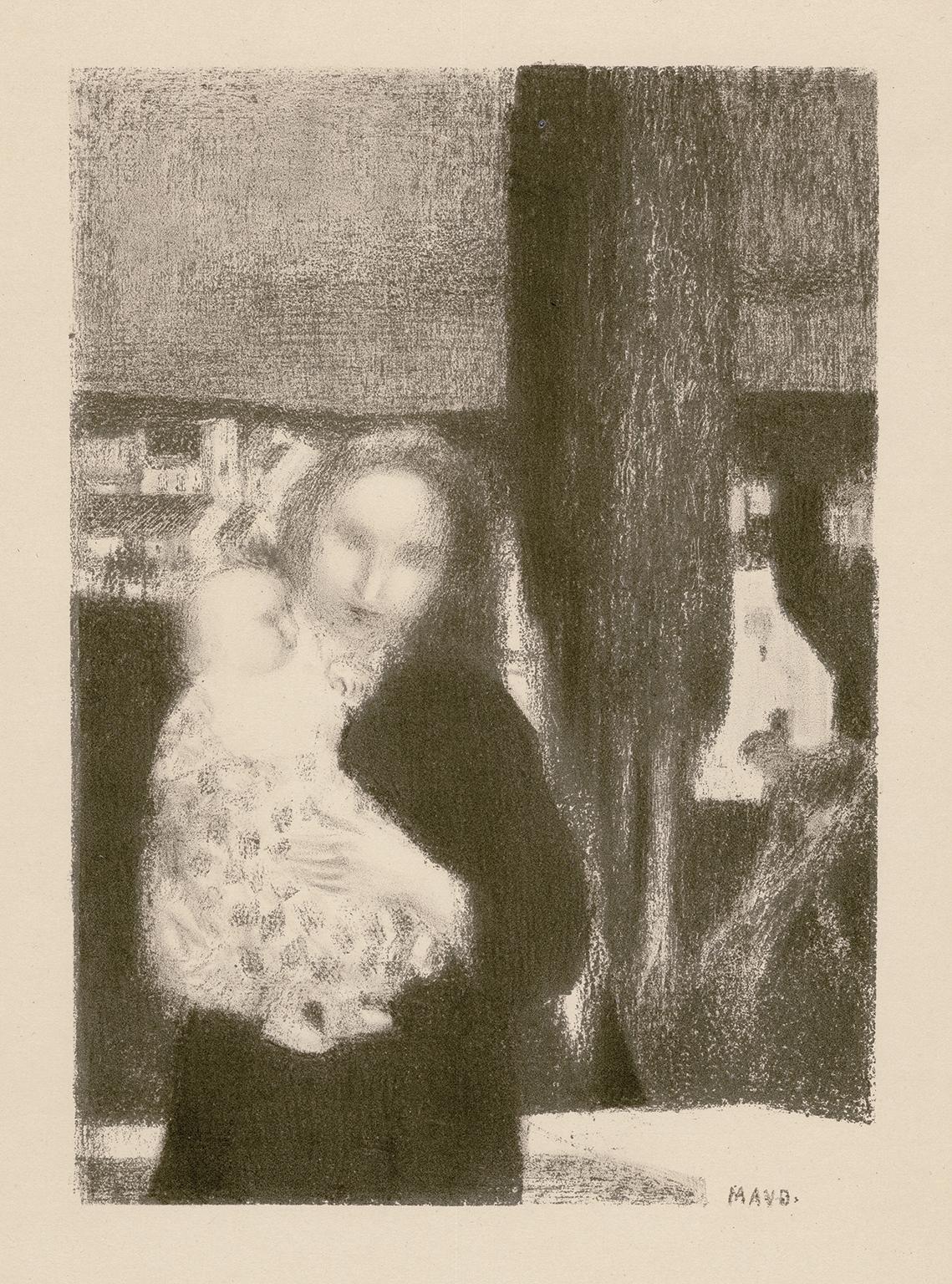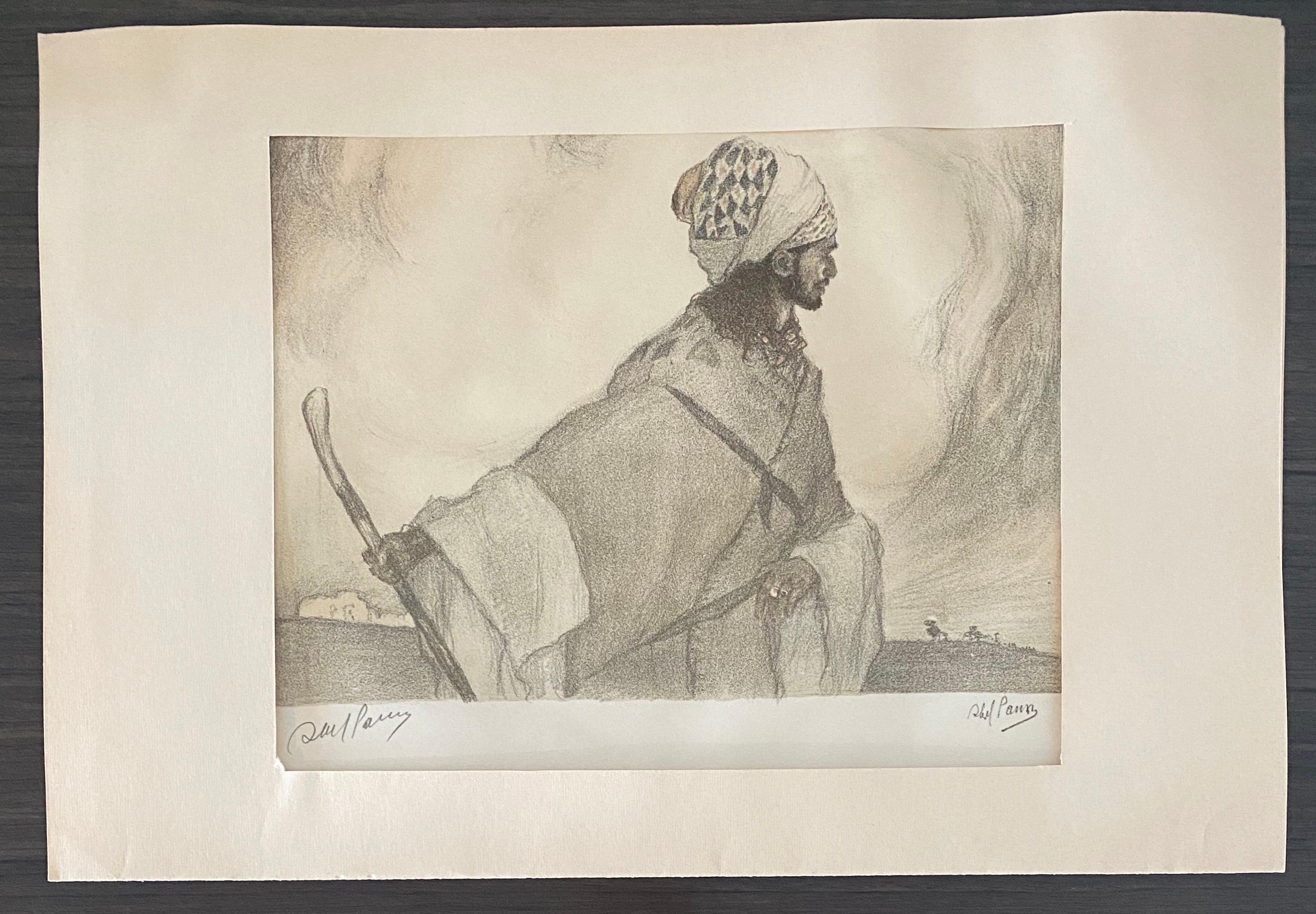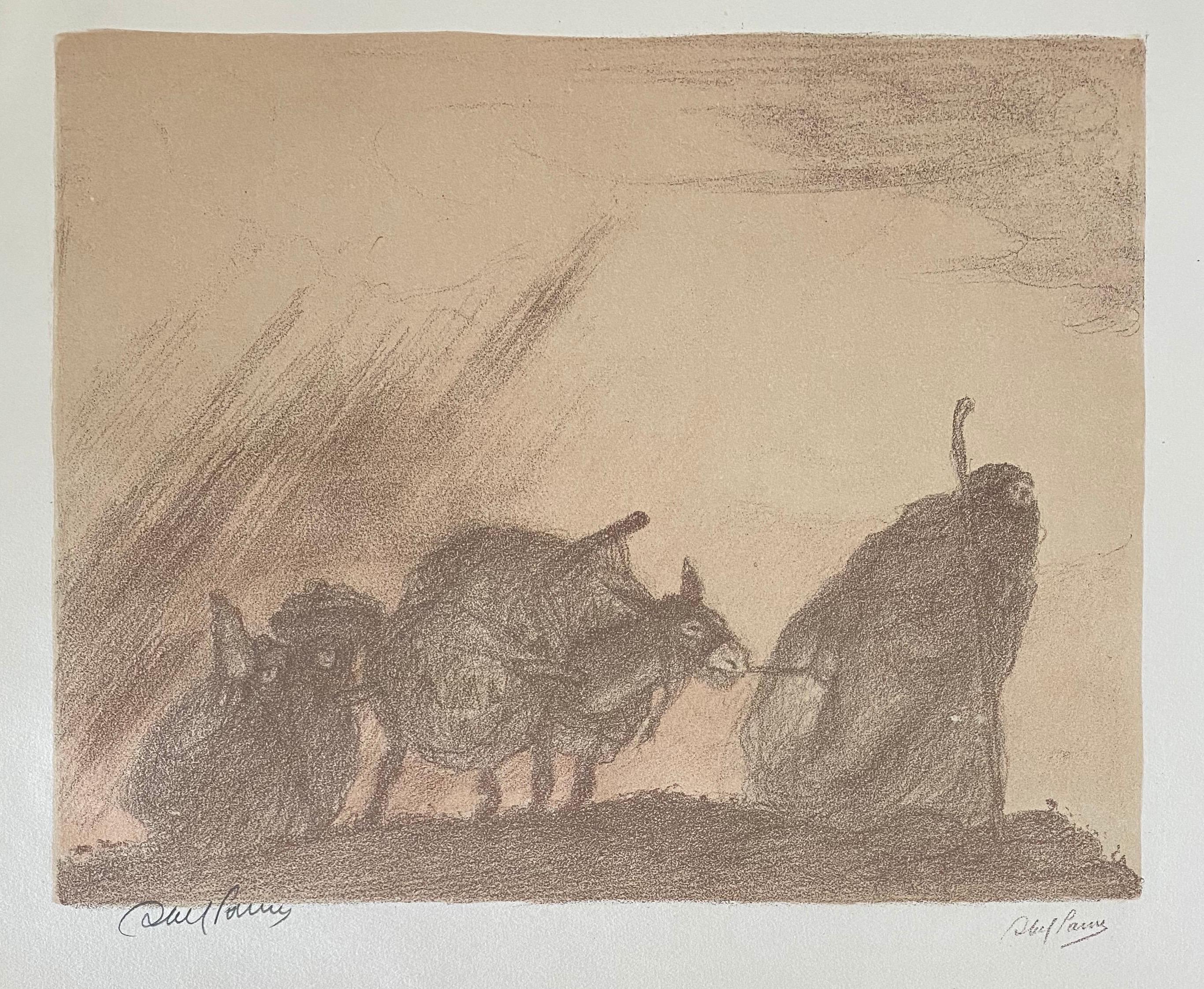Items Similar to Das Grausen - Lithograph After A. Kubin - 1903
Want more images or videos?
Request additional images or videos from the seller
1 of 7
After Alfred Kubin Das Grausen - Lithograph After A. Kubin - 19031922
1922
About the Item
Das Grausen is a lithograph realized after a work by Alfred Kubin in 1903, Hand-signed and titled, plate from Faksimiledrucke nach Kunstblättern, edition H. Von Weber.
Included a frame.
References: Arnason & Wheeler 1986, p. 88.
In very good conditions.
Alfred Leopold Isidor Kubin (1877-1959) was an Austrian printmaker illustrator, Kubin is considered an important representative of symbolism and Expressionism.He is noted for dark, spectral, symbolic fantasies, often assembled into thematic series of drawings.
The aquatint technique used by Klinger and Goya influenced the style of his works of this period, which are mainly ink and wash drawings of fantastical, often macabre subjects. Kubin produced a small number of oil paintings in the years between 1902 and 1910, but thereafter his output consisted of pen and ink drawing and lithograph, In 1911, he became associated with the Blaue Reiter group, and exhibited with them in Galerie Der Strum in Berlin in 1913.
This artwork is shipped from Italy. Under existing legislation, any artwork in Italy created over 70 years ago by an artist who has died requires a licence for export regardless of the work’s market price. The shipping may require additional handling days to require the licence according to the final destination of the artwork.
- Creator:After Alfred Kubin
- Creation Year:1922
- Dimensions:Height: 16.54 in (42 cm)Width: 13.78 in (35 cm)Depth: 0.08 in (2 mm)
- Medium:
- Movement & Style:
- Period:
- Condition:Insurance may be requested by customers as additional service, contact us for more information.
- Gallery Location:Roma, IT
- Reference Number:
About the Seller
4.9
Platinum Seller
These expertly vetted sellers are 1stDibs' most experienced sellers and are rated highest by our customers.
1stDibs seller since 2017
6,693 sales on 1stDibs
Typical response time: 2 hours
- ShippingRetrieving quote...Ships From: Rome, Italy
- Return PolicyA return for this item may be initiated within 14 days of delivery.
More From This SellerView All
- The European Macabre Dance N.7 - Lithograph by A. Martini - 1915By Alberto MartiniLocated in Roma, ITThe European Macabre Dance N.7 is a hand-colored lithograph, from the Series "La Danza Macabra Europea" illustrated by Alberto Martini (Oderzo, 1876 – Milan, 1954) in 1915. Signed on the plate, Original Edition. Published by Domenico Longo, Treviso. Handcolored lithographic postcards. Very good conditions. Alberto Martini (Oderzo, 1876 - Milan, 1954); was an Italian draftsman, painter, engraver and illustrator, forerunner of the surrealist movement...Category
1910s Symbolist Figurative Prints
MaterialsLithograph
- The European Macabre Dance N.38 - Lithograph by A. Martini - 1915By Alberto MartiniLocated in Roma, ITThe European Macabre Dance N.38 is a hand-colored lithograph, from the Series "La Danza Macabra Europea" illustrated by Alberto Martini (Oderzo, 1876 – Milan, 1954) in 1915. Signed ...Category
1910s Symbolist Figurative Prints
MaterialsLithograph
- The European Macabre Dance N.28 - Lithograph by A. Martini - 1915By Alberto MartiniLocated in Roma, ITThe European Macabre Dance N.28 is a hand-colored lithograph, from the Series "La Danza Macabra Europea" illustrated by Alberto Martini (Oderzo, 1876 – Milan, 1954) in 1915. Signed...Category
1910s Symbolist Figurative Prints
MaterialsLithograph
- The European Macabre Dance N.12 - Lithograph by A. Martini - 1915By Alberto MartiniLocated in Roma, ITThe European Macabre Dance N.12 is a hand-colored lithograph, from the Series "La Danza Macabra Europea" illustrated by Alberto Martini (Oderzo, 1876 – Milan, 1954) in 1915. Origina...Category
1910s Symbolist Figurative Prints
MaterialsLithograph
- The European Macabre Dance N.10 - Lithograph by A. Martini - 1915By Alberto MartiniLocated in Roma, ITThe European Macabre Dance N.10 is a hand-colored lithograph, from the Series "La Danza Macabra Europea" illustrated by Alberto Martini (Oderzo, 1876 – Milan, 1954) in 1915. Original Edition. Published by Domenico Longo, Treviso. Handcolored lithographic postcards. Very good conditions. Alberto Martini (Oderzo, 1876 - Milan, 1954); was an Italian draftsman, painter, engraver and illustrator, forerunner of the surrealist movement...Category
1910s Symbolist Figurative Prints
MaterialsLithograph
- Profil de Lumière - Lithograph after Odilon Redon - 1923By Odilon RedonLocated in Roma, ITProfil de Lumière is a phototype reproduction realized after Odilon Redon. They belong to the suite "Odilon Redon Peintre, Dessinateur et Graveur", published by Henri Felury in 192...Category
1920s Symbolist Figurative Prints
MaterialsLithograph
You May Also Like
- Untitled (Mother and Child)By Maurice DenisLocated in Myrtle Beach, SCMaurice Denis, Untitled (Mother and Child), lithograph, 1897, edition not stated. Signed in the stone, lower right. Annotated in linotype 'MAURICE DENIS, ORIGINAL LITHOGRAPHIE PAN III' in the lower left sheet corner. A fine, atmospheric impression, in warm, dark gray ink, on buff wove paper, with full margins (2 1/2 to 1 3/4 inches); a small discoloration in the bottom left sheet corner, otherwise in good condition. Image size 8 5/8 x 6 7/8 inches; sheet size 13 7/8 x 10 5/8 inches. As published in 'Pan', the leading German magazine of the period devoted to art and literature. Matted to museum standards, unframed. Collection: Los Angeles County Museum of Art. Reproduced: German Expressionist Prints...Category
1890s Symbolist Figurative Prints
MaterialsLithograph
- Abel Pann Israeli Bezalel School Lithograph Judaica Biblical Print Jewish ArtBy Abel PannLocated in Surfside, FLAbel Pann (1883–1963) was a European Jewish painter who settled in the Talpiot neighborhood of Jerusalem in the early twentieth century and taught at the Bezalel Academy of Art under...Category
Mid-20th Century Symbolist Figurative Prints
MaterialsLithograph
- Abel Pann Israeli Bezalel School Lithograph Judaica Biblical Print Jewish ArtBy Abel PannLocated in Surfside, FLAbel Pann (1883–1963) was a European Jewish painter who settled in the Talpiot neighborhood of Jerusalem in the early twentieth century and taught at the Bezalel Academy of Art under...Category
Mid-20th Century Symbolist Figurative Prints
MaterialsLithograph
- Abel Pann Israeli Bezalel School Lithograph Judaica Biblical Print Jewish ArtBy Abel PannLocated in Surfside, FLAbel Pann (1883–1963) was a European Jewish painter who settled in the Talpiot neighborhood of Jerusalem in the early twentieth century and taught at the Bezalel Academy of Art under...Category
Mid-20th Century Symbolist Figurative Prints
MaterialsLithograph
- Abel Pann Israeli Bezalel School Lithograph Judaica Biblical Print Jewish ArtBy Abel PannLocated in Surfside, FLAbel Pann (1883–1963) was a European Jewish painter who settled in the Talpiot neighborhood of Jerusalem in the early twentieth century and taught at the Bezalel Academy of Art under Boris Schatz. Abba Pfeffermann (later Abel Pann), born in Latvia or in Kreskowka, Vitebsk, Belarus, was a European Russian Jewish artist who immigrated to Ottoman Palestine and settled in Jerusalem. He was married to Esther Nussbaum. Pann's youngest son was killed in the 1947–1949 Palestine war. After that loss, he turned to painting scenes of the Holocaust. He died in Jerusalem in 1963. Pann studied the fundamentals of drawing for three months with the painter Yehuda Pen of Vitebsk, who also taught Marc Chagall. In his youth, he traveled in Russia and Poland, earning a living mainly as an apprentice in sign workshops. In 1898 he went south to Odessa, where he was accepted into the Academy of Fine Arts. In 1903, he was in Kishinev, where he documented the Kishinev pogrom with drawings; an effort that is thought to have contributed to his self-definition as an artist who chronicles Jewish history. Still in 1903, he moved to Paris, where he rented rooms in La Ruche, a Parisian building (which still exists) where Modigliani, Chagall, Chaim Soutine and other Jewish artists also lived. Pann studied at the French Academy under William-Adolphe Bouguereau. He earned his living primarily by drawing pictures for the popular illustrated newspapers of the era. In 1912, Boris Schatz, founder and director of the Bezalel Academy of Arts and Design visited Pann in Paris and invited him to come work in Jerusalem. In 1913, after traveling in Southern Europe and Egypt, Pann arrived in Jerusalem, where he had decided to settle for life. Pann went to see Schatz and it was decided that he would head the painting department at the Bezalel Academy for several months while Schatz embarked on an extensive overseas fund-raising trip. According to Haaretz art critic Smadar Sheffi, a work form this period with the simple title "Jerusalem" shows a cluster of buildings at sunset "with a sky in blazing orange." The painting is "more expressive and abstract that is typical of his work," and Sheffi speculates that "the encounter with the city" of Jerusalem was a "strong emotional experience" for the artist. Pann returned to Europe to arrange his affairs before moving permanently to the British Mandate of Palestine, but was caught on the continent by World War I. Pann's wartime paintings would prove to be among "the most important" of his career. He made many posters to support the French war effort. He also made a series of fifty drawings showing the extreme suffering of Jewish communities caught in the fighting between Germany, Poland and Russia. Art critic Smadar Sheffi regards them as "the most important part of his oeuvre." These "shocking" drawings put modern viewers in mind of depictions of the Holocaust. Pann's drawings were intended as journalistic documentation of the fighting and were successfully exhibited in the United States during the War. According to Pann's autobiography, the Russians, who were allied with the French, refused to allow a wartime exhibition of the drawings in France. According to The New York Times, the drawings were published in Paris during the war, but the government intervened to block their distribution on the grounds that they "reflected damagingly upon an ally" (Russia). Upon his return to Jerusalem in 1920, Pann took up a teaching position at the Bezalel Academy and wrote that he was about to embark on his life-work, the painting and drawing of scenes from the Hebrew Bible. He returned briefly to Vienna, where he met and married Esther Nussbaum and purchased a lithographic press, which the couple brought home to Jerusalem. Pann began work on a series of lithographs intended to be published in an enormous illustrated Bible, and although that series was never completed, he is widely admired for the series of pastels inspired by Bible stories that he began in the 1940s. The iconography of these works is linked to the 19th century orientalism. He was part of a movement of contemporary Jewish artists interested in Biblical scenes, including Ephraim Moses Lilien...Category
Mid-20th Century Symbolist Figurative Prints
MaterialsLithograph
- Abel Pann Israeli Bezalel School Lithograph Judaica Biblical Print Jewish ArtBy Abel PannLocated in Surfside, FLAbel Pann (1883–1963) was a European Jewish painter who settled in the Talpiot neighborhood of Jerusalem in the early twentieth century and taught at the Bezalel Academy of Art under...Category
Mid-20th Century Symbolist Figurative Prints
MaterialsLithograph





